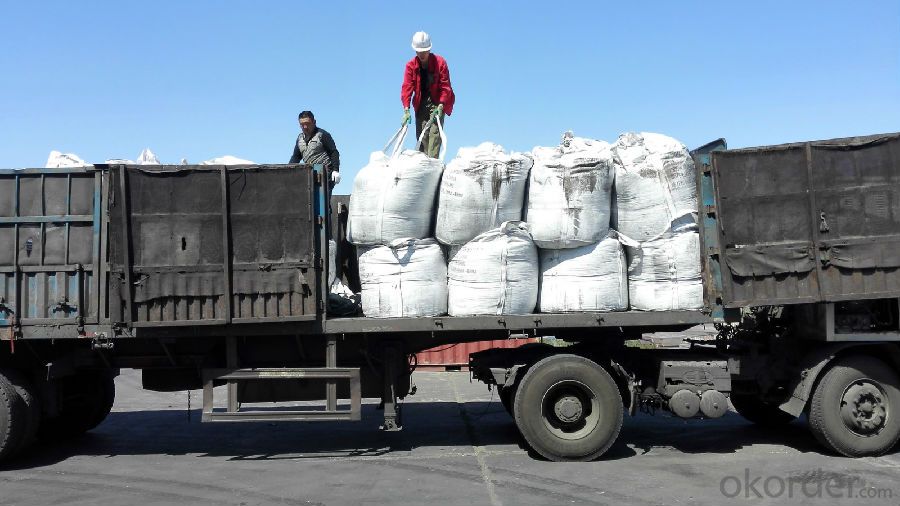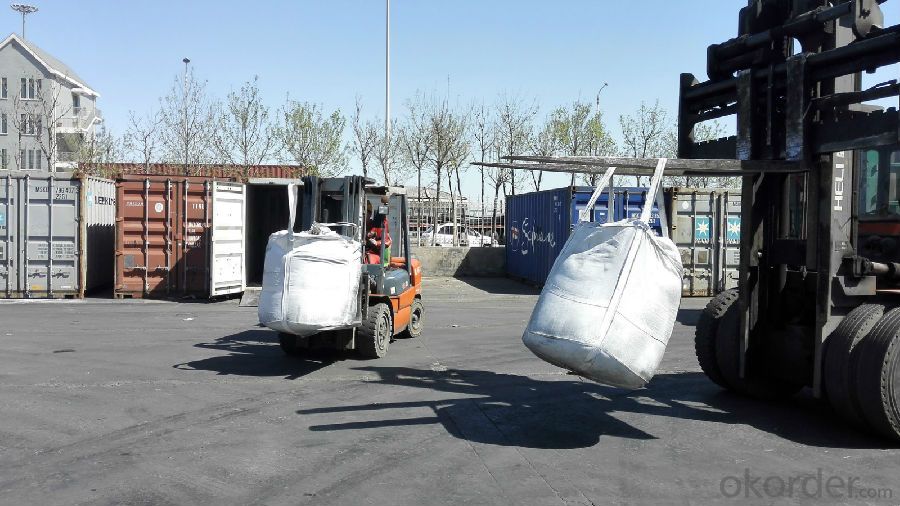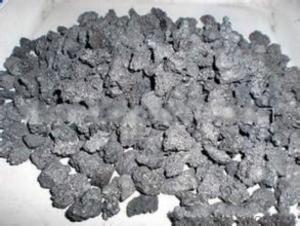Gas Calcined anthracite coal used for carbon increasing
- Loading Port:
- Tianjin
- Payment Terms:
- TT OR LC
- Min Order Qty:
- 19.1
- Supply Capability:
- 991 m.t./month
OKorder Service Pledge
OKorder Financial Service
You Might Also Like
Introduction:
Calcined anthracite can be called carbon additive, carbon raiser, recarburizer, injection coke, charging coke, gas calcined anthracite.It is playing more and more important role in the industry
Best quality Anthracite as raw materials through high temperature calcined at over 2000℃ by the DC electric calciner with results in eliminating the moisture and volatile matter from Anthracite efficiently, improving the density and the electric conductivity and strengthening the mechanical strength and anti-oxidation. It has good characteristics with low ash, low resistivity, low sulphur, high carbon and high density. It is the best material for high quality carbon products. It is used as carbon additive in steel industry or fuel.
Features:
G-High Calcined Anthracite is produced when Anthracite is calcined under the temperature of 1240°C in vertical shaft furnaces. G-High Calcined Anthracite is mainly used in electric steel ovens, water filtering, rust removal in shipbuilding and production of carbon material. We like to you to visit our company
Specifications:
F.C.% | 95MIN | 94MIN | 93MIN | 92MIN | 90MIN | 85MIN | 84MIN |
ASH % | 4MAX | 5MAX | 6 MAX | 6.5MAX | 8.5MAX | 12MAX | 13MAX |
V.M.% | 1 MAX | 1MAX | 1.0MAX | 1.5MAX | 1.5MAX | 3 MAX | 3 MAX |
SULFUR % | 0.3MAX | 0.3MAX | 0.3MAX | 0.35MAX | 0.35MAX | 0.5MAX | 0.5MAX |
MOISTURE % | 0.5MAX | 0.5MAX | 0.5MAX | 0.5MAX | 0.5MAX | 1MAX | 1MAX |
Pictures




FAQ:
Packing:
(1). Waterproof jumbo bags: 800kgs~1100kgs/ bag according to different grain sizes;
(2). Waterproof PP woven bags / Paper bags: 5kg / 7.5kg / 12.5kg / 20kg / 25kg / 30kg / 50kg small bags;
(3). Small bags into jumbo bags: waterproof PP woven bags / paper bags in 800kg ~1100kg jumbo bags.
Payment terms
20% down payment and 80% against copy of B/L.
Workable LC at sight,
- Q:How does carbon affect the formation of wildfires?
- Carbon does not directly affect the formation of wildfires, but it plays a crucial role in their intensity and duration. Carbon is a key component of organic matter, such as vegetation and dead plants, which serve as fuel for wildfires. When a wildfire occurs, the heat causes the carbon in these fuels to combine with oxygen, resulting in the process of combustion. This combustion releases energy in the form of heat, light, and gases, including carbon dioxide (CO2) and carbon monoxide (CO). The presence of carbon-rich fuels significantly contributes to the spread and intensity of wildfires. Dry and dead vegetation, often referred to as fuel loads, are highly flammable and allow fires to rapidly spread. Additionally, the carbon content in these fuels determines the amount of energy released during combustion. Consequently, the more carbon-rich the fuel, the more intense the fire will be. Moreover, the combustion of carbon during wildfires releases significant amounts of carbon dioxide into the atmosphere. Carbon dioxide is a greenhouse gas, which traps heat in the Earth's atmosphere and contributes to the greenhouse effect, leading to global warming. Increased levels of carbon dioxide in the atmosphere exacerbate climate change, further influencing the frequency and severity of wildfires. In summary, carbon indirectly affects the formation of wildfires by serving as fuel for combustion. The carbon content in vegetation and dead plants determines the intensity and spread of wildfires, while the release of carbon dioxide during combustion contributes to the long-term impact of wildfires on climate change.
- Q:How many points can Yongan change for 1 carbon coins?
- Yongan APP one hundred carbon points, change a carbon coin
- Q:What is the composition of carbon in stainless steel?
- Adjust the hardness, general carbon content, the higher the relative hardness is relatively hard. But no, the higher the better, the carbon content needs to be well controlled. For example, if the welding position is too high carbon, it will lead to brittle weld and easy to crack.
- Q:What are the impacts of carbon emissions on marine life?
- Carbon emissions, particularly in the form of carbon dioxide (CO2) released from burning fossil fuels, have significant impacts on marine life. One of the primary effects is ocean acidification, which occurs when excess CO2 is absorbed by seawater, leading to a decrease in pH levels. This acidification can have detrimental effects on marine organisms, especially those with calcium carbonate shells or skeletons, such as corals, mollusks, and some plankton. As the pH levels decrease, it becomes harder for these organisms to build and maintain their shells. This can result in reduced growth rates, weakened shells, and increased vulnerability to predation and disease. Additionally, the dissolution of calcium carbonate shells due to ocean acidification can disrupt the entire food chain, as many organisms rely on these shells for protection or as a food source. Furthermore, carbon emissions contribute to global warming, leading to rising sea temperatures. Warmer waters can cause coral bleaching, a phenomenon where corals expel the colorful algae living within their tissues, resulting in the loss of their main food source and leading to their eventual death. Coral reefs are vital ecosystems that support a diverse array of marine life, and their decline has far-reaching consequences on biodiversity and coastal communities that rely on them for tourism and fisheries. The impacts of carbon emissions on marine life extend beyond individual species and ecosystems. Climate change, driven by carbon emissions, can disrupt ocean currents, alter weather patterns, and cause changes in nutrient availability. These changes can affect the distribution and abundance of marine organisms, leading to shifts in species composition and potential loss of biodiversity. It is worth noting that the impacts of carbon emissions on marine life are interconnected with other stressors such as overfishing, pollution, and habitat destruction. These combined pressures exacerbate the vulnerability of marine ecosystems and increase the risks of irreversible damage. To mitigate the impacts of carbon emissions on marine life, reducing greenhouse gas emissions is crucial. Transitioning to cleaner and renewable energy sources, improving energy efficiency, and adopting sustainable practices can help slow down the rate of ocean acidification and global warming. Additionally, protecting and restoring marine habitats, implementing sustainable fishing practices, and reducing pollution can enhance the resilience of marine ecosystems and promote the recovery of marine life.
- Q:How does carbon impact ocean acidity?
- Ocean acidification is caused by carbon, which impacts the acidity of the ocean. When seawater absorbs carbon dioxide (CO2) from the atmosphere, it reacts with water molecules and forms carbonic acid. This process lowers the pH levels of the ocean, making it more acidic. Human activities, including burning fossil fuels, deforestation, and industrial processes, are the primary sources of carbon dioxide in the atmosphere. As these activities increase the concentration of CO2 in the atmosphere, more of it is absorbed by the oceans. The increase in acidity has negative effects on marine life. Organisms with calcium carbonate shells, such as coral reefs, shellfish, and some plankton species, are particularly vulnerable to ocean acidification. The higher acidity makes it difficult for these organisms to build and maintain their shells, resulting in reduced growth rates and increased mortality. Ocean acidification also disrupts the entire marine food web. It upsets the balance between predators and prey, as some plankton species struggle to develop and survive in acidic conditions. This can have a ripple effect on the entire ecosystem, affecting fish populations, marine mammals, and even humans who rely on seafood for sustenance. Furthermore, ocean acidification has significant economic consequences. Industries like commercial fisheries and tourism, which depend on healthy marine ecosystems, can suffer from the decline in fish populations and the degradation of coral reefs. To mitigate the impacts of carbon on ocean acidity, it is crucial to reduce carbon dioxide emissions and shift towards cleaner and more sustainable energy sources. Measures like creating marine protected areas and implementing sustainable fishing practices can also help protect and restore marine ecosystems, thereby mitigating the effects of ocean acidification.
- Q:What is carbon nanomembrane?
- Carbon nanomembrane is a thin, flexible sheet made up of carbon atoms arranged in a precise pattern. It has unique properties such as high strength, electrical conductivity, and impermeability, making it suitable for various applications like filtration, energy storage, and biomedical devices.
- Q:What are the consequences of increased carbon emissions on educational systems?
- Increased carbon emissions have profound consequences on educational systems. One of the major consequences is the negative impact on the health and well-being of students and teachers. Carbon emissions contribute to air pollution, which can lead to respiratory problems, allergies, and other health issues. This, in turn, affects attendance rates and overall student performance. Furthermore, the effects of climate change caused by carbon emissions, such as extreme weather events and rising temperatures, can disrupt educational infrastructure. Schools may be closed or damaged due to hurricanes, floods, or heatwaves, leading to a loss of instructional time and disruption to the learning environment. In addition, increased carbon emissions contribute to the depletion of natural resources, such as water and food, which can have severe consequences for educational systems. In regions heavily reliant on agriculture, climate change can disrupt food production and availability, leading to malnutrition and reduced cognitive development in children. Lack of access to clean water can also impact sanitation in schools, increasing the risk of diseases and impacting students' ability to concentrate and learn. Moreover, the consequences of increased carbon emissions extend beyond physical health and infrastructure. Climate change is a complex global issue that requires an understanding of scientific concepts and critical thinking skills to address. However, inadequate education on climate change and its causes can hinder students' ability to comprehend and respond to this pressing issue. Furthermore, the economic impacts of climate change resulting from increased carbon emissions can strain educational systems. Governments may have to divert resources away from education to address climate-related disasters and their aftermath. Limited funding for education can lead to reduced access to quality education, inadequate facilities, and lower teacher salaries, all of which can negatively impact the overall quality of education provided. In conclusion, increased carbon emissions have wide-ranging consequences on educational systems. From the health and well-being of students and teachers to disruptions in infrastructure and access to resources, the effects of carbon emissions can hinder educational outcomes. Addressing climate change and reducing carbon emissions is crucial not just for the environment but also for the future of education.
- Q:What is carbon neutral certification?
- Carbon neutral certification is a process by which an organization, product, or service is evaluated and verified to have a net-zero carbon footprint. This means that the entity in question has taken significant measures to reduce its greenhouse gas emissions and has offset the remaining emissions through the purchase of carbon credits or investments in projects that mitigate or remove carbon dioxide from the atmosphere. To achieve carbon neutrality, the organization or product undergoes a rigorous assessment that includes measuring its carbon emissions, setting reduction targets, implementing initiatives to reduce its carbon footprint, and tracking progress. Once the emissions have been reduced as much as possible, any remaining emissions are offset by investing in verified projects such as reforestation, renewable energy, or energy efficiency projects that remove or reduce greenhouse gases from the atmosphere. The certification process is typically carried out by an independent third-party organization that evaluates and verifies the organization's carbon neutrality claims. This ensures transparency and credibility in the certification process. Once certified, the organization or product can use the carbon neutral label to demonstrate its commitment to environmental sustainability and responsible carbon management. Carbon neutral certification is important as it provides a standardized and recognized way for organizations and products to demonstrate their commitment to combating climate change. It allows consumers and stakeholders to make informed choices by supporting entities that have taken concrete steps to reduce their carbon emissions and contribute to a more sustainable future. Additionally, carbon neutral certification encourages organizations to adopt sustainable practices and invest in projects that have a positive environmental impact, thereby accelerating the transition to a low-carbon economy.
- Q:What are the economic impacts of carbon emissions?
- The economic impacts of carbon emissions are significant and wide-ranging. Carbon emissions, primarily from the burning of fossil fuels, contribute to climate change and global warming. These changes in the climate have a direct impact on various economic sectors and can lead to both short-term and long-term economic consequences. One of the most notable economic impacts of carbon emissions is the cost of dealing with the effects of climate change. Extreme weather events, such as hurricanes, floods, and droughts, become more frequent and intense as a result of carbon emissions. These events can cause extensive damage to infrastructure, homes, and businesses, leading to significant economic losses. For example, in 2017, the United States experienced a record-breaking hurricane season, with hurricanes Harvey, Irma, and Maria causing an estimated $265 billion in damages. Moreover, carbon emissions also affect agricultural productivity. Climate change alters temperature and precipitation patterns, which can disrupt crop production and decrease yields. This, in turn, affects food prices and availability, impacting both consumers and farmers. Additionally, carbon emissions contribute to the acidification of oceans, which can harm marine ecosystems and disrupt fisheries, leading to economic losses for fishing communities. Furthermore, carbon emissions have implications for public health, which can result in economic burdens. Air pollution caused by carbon emissions can lead to respiratory and cardiovascular illnesses, increasing healthcare costs and reducing workforce productivity. In addition, extreme heatwaves, exacerbated by carbon emissions, can have a detrimental impact on worker productivity and labor capacity, affecting economic output. To mitigate the economic impacts of carbon emissions, many countries have implemented policies and regulations to reduce greenhouse gas emissions. These policies often include carbon pricing mechanisms, such as carbon taxes or cap-and-trade systems, which aim to incentivize the transition to cleaner energy sources and reduce carbon emissions. While these policies may have short-term economic costs, they can also create opportunities for innovation and the development of green technologies, which can lead to long-term economic benefits. In conclusion, the economic impacts of carbon emissions are significant and multifaceted. From the costs of dealing with climate-related disasters to the effects on agriculture, public health, and productivity, carbon emissions have far-reaching consequences. Addressing these impacts through the implementation of effective climate policies is crucial to mitigate the economic risks and foster a sustainable and resilient economy.
- Q:How does carbon impact the availability of renewable energy sources?
- Carbon impacts the availability of renewable energy sources in a number of ways. Firstly, carbon emissions from the burning of fossil fuels contribute to climate change, which is a significant threat to the availability and sustainability of renewable energy sources. The increased frequency and intensity of extreme weather events caused by climate change can damage renewable energy infrastructure, such as wind turbines and solar panels. Secondly, carbon-intensive industries, such as coal mining and oil extraction, can limit the growth and development of renewable energy technologies. These industries have historically received substantial subsidies and support from governments, which can hinder the progress of renewable energy by diverting resources and investment away from cleaner alternatives. Furthermore, carbon emissions contribute to air pollution, which can have negative impacts on the efficiency and performance of renewable energy systems. For example, air pollution can reduce the amount of sunlight reaching solar panels or obstruct wind flow to turbines, thereby decreasing their energy output. Additionally, the reliance on carbon-based energy sources creates a significant market competition for renewable energy. Fossil fuels often have lower costs due to their established infrastructure and economies of scale, making it challenging for renewable energy sources to compete on a cost basis. This can limit the availability and accessibility of renewable energy options, particularly in developing countries where fossil fuels are often the cheaper and more readily available option. To address these challenges, it is crucial to reduce carbon emissions through transitioning to renewable energy sources and implementing policies that incentivize their adoption. By reducing carbon emissions, we can mitigate the impacts of climate change on renewable energy infrastructure and create a more conducive environment for the development and deployment of clean energy technologies.
1. Manufacturer Overview |
|
|---|---|
| Location | |
| Year Established | |
| Annual Output Value | |
| Main Markets | |
| Company Certifications | |
2. Manufacturer Certificates |
|
|---|---|
| a) Certification Name | |
| Range | |
| Reference | |
| Validity Period | |
3. Manufacturer Capability |
|
|---|---|
| a)Trade Capacity | |
| Nearest Port | |
| Export Percentage | |
| No.of Employees in Trade Department | |
| Language Spoken: | |
| b)Factory Information | |
| Factory Size: | |
| No. of Production Lines | |
| Contract Manufacturing | |
| Product Price Range | |
Send your message to us
Gas Calcined anthracite coal used for carbon increasing
- Loading Port:
- Tianjin
- Payment Terms:
- TT OR LC
- Min Order Qty:
- 19.1
- Supply Capability:
- 991 m.t./month
OKorder Service Pledge
OKorder Financial Service
Similar products
New products
Hot products
Hot Searches




























